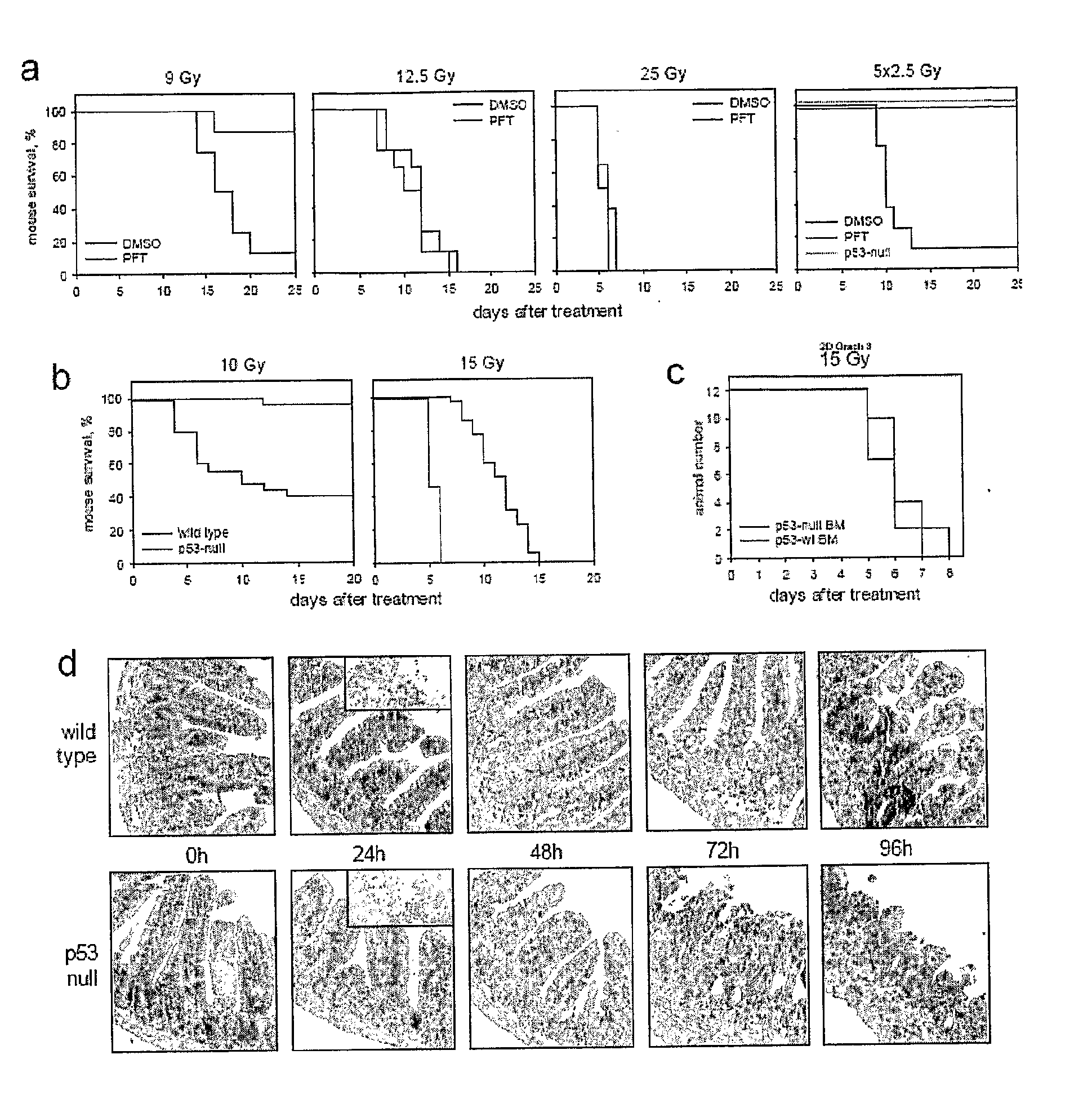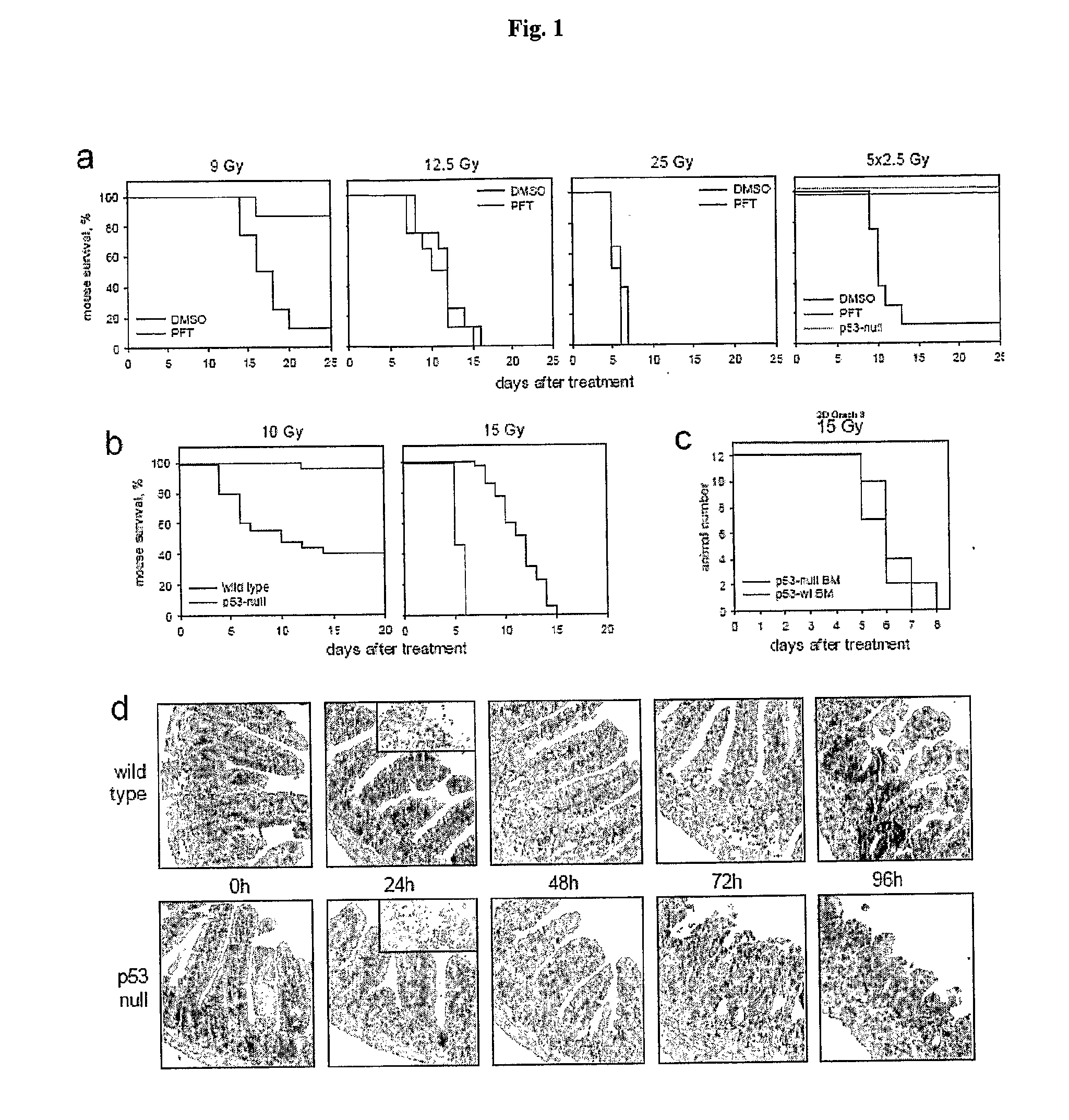Flagellin Related Polypeptides and Uses Thereof
a polypeptide and polypeptide technology, applied in the field of flagellin related polypeptides, can solve the problems of complex natural sensitivity of such tissues, risky normal rapidly dividing or apoptosis-prone tissues, and well-known side effects, and achieve the effect of preventing sepsis
- Summary
- Abstract
- Description
- Claims
- Application Information
AI Technical Summary
Benefits of technology
Problems solved by technology
Method used
Image
Examples
example 1
P53 Deficiency Accelerated Development of GI Syndrome in Mice
[0152]The primary cause of death from ionizing radiation (IR) of mammals depends on the radiation dose. At doses of up to 9-10 Gy, mice die 12-20 days later, primarily from lethal bone marrow depletion-hematopoietic (HP) syndrome. At this dose, irradiated mice can be rescued from lethality by bone marrow transplantation. Animals that receive >15 Gy die between 7-12 days after treatment (before hematopoietic syndrome can kill them) from complications of damage to the small intestine-gastrointestinal (G1) syndrome. In both cases of HP and GI syndromes, lethal damage of tissues starts from massive p53-dependent apoptosis. This observation allowed us earlier to suggest that p53 could be a determinant of radiation-induced death. Consistently, p53-deficient mice were resistant to doses of radiation that kill through HP syndrome, and lethality of wild type animals receiving 6-11 Gy of gamma radiation could be reduced by temporary...
example 2
Flagellin Delays Mouse Death Caused by IR-Induced GI Syndrome
[0154]Whole body irradiation of mice with 15 Gy gamma radiation caused death within 8 days from GI syndrome providing a conventional model of radiation induced damage of GI tract. To test whether flagellin was capable of protecting GI epithelium from IR, we tested the effect of i.v.-injected flagellin on the dynamics of mouse lethality after 15 Gy of radiation. We used a range of flagellin doses, all of which were significantly lower than the highest tolerable dose known from literature (300 μg / mouse). Irradiation was done 4 hours post treatment. The results of a representative experiment are shown in FIG. 4. As expected, control irradiated mice (that received PBS i.v.) died between 5 and 8 days post-treatment. Animals that received flagellin lived significantly longer; the extension of animal survival correlated with the dose of flagellin. Pathomorphological analysis of the small intestine on day 7 after irradiation revea...
example 3
Flagellin Rescues Mice From Lethal IR-Induced Hematopoietic Syndrome
[0155]We next tested whether flagellin had an effect on mouse IR-induced death from BP syndrome that was experimentally induced by lower radiation doses (usually up to 11 Gy) that are incapable of causing lethal GI toxicity. The experiments were done similarly to the above-described ones (FIGS. 14 and 15), however, instead of 15Gy, mice received 10Gy, the dose that caused 100% killing in control group by day 13 (FIG. 6). Flagellin-treated group (5 μg / mouse) showed complete protection from this dose of IR surprisingly indicating that flagellin-mediated radioprotection acts not only against GI but also against HP IR-induced syndromes.
PUM
| Property | Measurement | Unit |
|---|---|---|
| time points | aaaaa | aaaaa |
| diameter | aaaaa | aaaaa |
| diameter | aaaaa | aaaaa |
Abstract
Description
Claims
Application Information
 Login to View More
Login to View More - R&D
- Intellectual Property
- Life Sciences
- Materials
- Tech Scout
- Unparalleled Data Quality
- Higher Quality Content
- 60% Fewer Hallucinations
Browse by: Latest US Patents, China's latest patents, Technical Efficacy Thesaurus, Application Domain, Technology Topic, Popular Technical Reports.
© 2025 PatSnap. All rights reserved.Legal|Privacy policy|Modern Slavery Act Transparency Statement|Sitemap|About US| Contact US: help@patsnap.com



